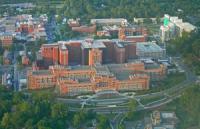-
TRUTH DECAYUnmasking “Clandestine,” the Figure Behind the Viral “Ukrainian Biolab” Conspiracy Theory
“Clandestine,” the man behind the viral biolab conspiracy theory, has been identified as Jacob Creech, a self-described former restaurant manager and Army National Guard veteran living in rural Virginia. The discovery highlights how a fringe QAnon figure, harnessing the power of social media, sparked a viral conspiracy theory which, in just a few weeks, made its way from QAnon to the world stage, amplified by Tucker Carlson, extreme far-right activists, the Proud Boys, Steve Bannon – and even the Kremlin.
-
-
TRUTH DECAY‘Ukraine Biolabs’: How Attempts to Debunk a Conspiracy Theory Only Helped It Spread
As Russian forces moved into Ukraine on 24 February, stories of U.S.-funded biolabs and bioweapon research in Ukraine began to spread on social media. The false claims spread from right-wing circles but became more wide-spread, and were soon picked up by Fox News host Tucker Carlson. It wasn’t long until the Russian government, which had spread tales of Ukrainian biolabs in the past, adopted the narrative as a belated justification for the invasion. But, ironically, the very effort to debunk the Russian propaganda promoted by Carlson and Russia only gave to story more oxygen.
-
-
R&DStudy: NIH funding generates large numbers of private-sector patents

Research grants issued by the National Institutes of Health (NIH) contribute to a significant number of private-sector patents in biomedicine, according to a new study. The study, published in the journal Science, examines twenty-seven years of data and finds that 31 percent of NIH grants, which are publicly funded, produce articles that are later cited by patents in the biomedical sector. “The impact on the private sector is a lot more important in magnitude than what we might have thought before,” says one of the researchers.
-
-
Pathogen detectionNew technology sheds light on viruses
Scientists develop diagnostic tests that rapidly detect disease-causing viruses in animals and humans; the scientists using a new technology called surface-enhanced Raman scattering, or SERS
-
-
Emergency communicationCSC wins $86 million task order for emergency communications
On Wednesday CSC announced that it had won an $86 million task order from DHS to continue providing emergency priority telecommunication services for the agency
-
-
Abbott shows new pathogen detector
Illinois-based pharmaceutical company Abbott unveiled a new assay system that can accurately detect seventeen different bio-threat pathogens; among different bio-agents targeted in the new test are Bacillus anthracis, E. coli, salmonella, Ebola virus, and avian influenza viruses; the company says the new method provides results in less than eight hours
-
-
Alien life on EarthNew life form -- thriving on arsenic -- found on Earth
“Life as we know it requires particular chemical elements and excludes others—- But are those the only options? How different could life be?” — asks Arizona State University professor Ariel Anbar; researchers find that the toxic element arsenic can replace the essential nutrient phosphorus in biomolecules of a naturally occurring bacterium; the finding expands the scope of the search for life beyond Earth
-
-
In the trenchesDARPA looking for methods to freeze soldiers with brain injuries
Traumatic brain injuries are caused by repeated exposure to blasts, specifically the “supersonic wave” of highly-pressurized air they emit; within a fraction of a second after impact, brain cells, tissues, and blood vessels are stretched, torn, and distorted; over the hours, days, and months that follow, altered brain processes create a snowball effect of damage — which is why symptoms often don’t show up until troops come home; in its solicitation, DARPA notes that a portable brain-cooling unit, deployed in the field, could “extend the golden hour of patient survivability and increase the chances for full recovery”
-
- All
- Regional
- Water
- Biometrics
- Borders/Immig
- Business
- Cybersecurity
- Detection
- Disasters
- Government
- Infrastructure
- International
- Public health
- Public Safety
- Communication interoperabillity
- Emergency services
- Emergency medical services
- Fire
- First response
- IEDs
- Law Enforcement
- Law Enforcement Technology
- Military technology
- Nonlethal weapons
- Nuclear weapons
- Personal protection equipment
- Police
- Notification /alert systems
- Situational awareness
- Weapons systems
- Sci-Tech
- Sector Reports
- Surveillance
- Transportation
Advertising & Marketing: advertise@newswirepubs.com
Editorial: editor@newswirepubs.com
General: info@newswirepubs.com
2010-2011 © News Wire Publications, LLC News Wire Publications, LLC
220 Old Country Road | Suite 200 | Mineola | New York | 11501
Permissions and Policies
Editorial: editor@newswirepubs.com
General: info@newswirepubs.com
2010-2011 © News Wire Publications, LLC News Wire Publications, LLC
220 Old Country Road | Suite 200 | Mineola | New York | 11501
Permissions and Policies
